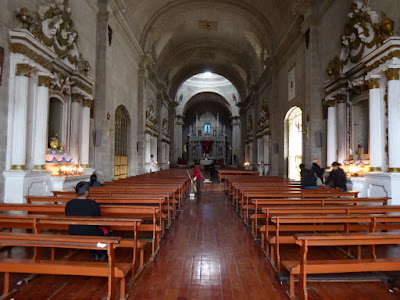Our second Lake Titicaca stop was the island of Taquile, close also to Puno, another relatively closed society but which welcomes limited tourism. Residents of Taquile speak Quechua, the language of the Incas, although their dress is distinctly Spanish. The men's pants are matador-style. Taquile is famous for its textiles, and, interestingly, it is the men who do most of the knitting. When a man proposes, he must present his bride-to-be with a knitted cap that will actually hold water. If it fails, she tells him to try again and come back in six months. Married men wear red caps; single men red and white. Women wear black shawls. Anyhow, it is a collectivist society, abiding by the three Inca laws: do not lie, do not steal, do not be lazy. All goods sold are through the cooperative, 90% going to the producer, 10% to the community.
 |
| The hike from the dock to the top of the hill just about did me in |
 |
| Lay of the land: mostly potatoes |
 |
| Black shawl |
 |
| Widowers? |
 |
| Helpful milepost |
 |
| See it to believe it |
 |
| Outside the Coop |
 |
They also spin who only stand and wait; in rural areas, people
often walk and spin |
 |
At lunch, a show on Taquile textiles; I should
mention that the restaurant that normally serves
this tour said sorry, all sold out from the feria;
come again next week; our resourceful guide
found an alternative on this island of 2,200 souls,
ready to serve 40 persons, without losing a minute |
 |
The guide, Manuel, demonstrating the sashes worn by men of
the island |
 |
| More demonstration |
 |
| Caps...so impressive |
 |
| Little multi-colored bags for carrying one's coca leaves |
 |
| Sashes |
 |
| Including this one, made with the wife's hair |
 |
| Bolivia in the cloudy distance |
 |
Taquilenos don't use Head and Shoulders; rather a sudsy mixture
made by grinding this plant |
 |
| Suds |
 |
| More demonstration |
 |
| Main square |
 |
| Street food |
 |
| Among Peru's plethora of interesting hats |
 |
| En route to the Cap 40 Max |
 |
| Us, there, me, winded |
 |
| One of the island's two "harbors"; another fascinating visit |












































